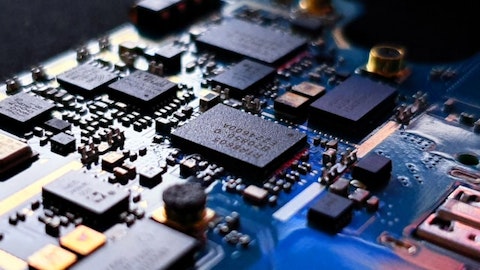Broadcom Inc. (NASDAQ:AVGO) Q1 2023 Earnings Call Transcript March 2, 2023
Operator: Welcome to Broadcom Inc.’s First Quarter Fiscal Year 2023 Financial Results Conference Call. At this time, for opening remarks and introductions, I would like to turn the call over to Ji Yoo, Head of Investor Relations of Broadcom Inc.
Ji Yoo: Thank you, Operator, and good afternoon, everyone. Joining me on today’s call are Hock Tan, President and CEO; Kirsten Spears, Chief Financial Officer; and Charlie Kawwas, President Semiconductor Solutions Group. Broadcom distributed a press release and financial tables after the market closed, describing our financial performance for the first quarter fiscal year 2023. If you did not receive a copy, you may obtain the information from the Investors section of Broadcom’s website at broadcom.com. This conference call is being webcast live and an audio replay of the call can be accessed for one year through the Investors section of Broadcom’s website. During the prepared comments, Hock and Kirsten will be providing details of our first quarter fiscal year 2023 results, guidance for our second quarter, as well as commentary regarding the business environment.
We will take questions after the end of our prepared comments. Please refer to our press release today and our recent filings with the SEC for information on the specific risk factors that could cause our actual results to differ materially from the forward-looking statements made on this call. In addition to U.S. GAAP reporting, Broadcom reports certain financial measures on a non-GAAP basis. A reconciliation between GAAP and non-GAAP measures is included in the tables attached to today’s press release. Comments made during today’s call will primarily refer to our non-GAAP financial results. I will now turn the call over to Hock.
Hock Tan: Thank you, Ji, and thank you, everyone, for joining us today. In our fiscal 20 — in our fiscal Q1 2023, consolidated net revenue that was — revenue was $8.9 billion, up 16% year-on-year. Semiconductor Solutions revenue increased 21% year-on-year to $7.1 billion. While as we expected, Infrastructure Software declined 1% year-on-year to $1.8 billion, even as our core software sustained growth of 5% year-on-year. Stepping back, let me sum up what happened in Q1. From our view, infrastructure spending continues to be up, particularly in service providers, even as hyperscale and enterprise sustain. Spending in technology for infrastructure has been strong, showing double-digit growth for nine consecutive quarters. We continue to be booked for fiscal 2023 and our lead times and visibility on semiconductors remain largely at 50 weeks.
While there have been a small number of requests to push out certain orders, we know that these are the exceptions and they have not had a material impact on our business. Because we ship linearly throughout the quarter to our customers, inventory on our books has been consistent around 80 days and overall inventory of Broadcom products across the ecosystem remains very well managed. We continue, needless to say, to be very disciplined in shipping our backlog only as and when needed by our end customers. With that, let me now provide more color on each of our end markets. Starting with networking. Networking revenue was $2.3 billion and was up 20% year-on-year, in line with guidance, representing 32% of our semiconductor revenue. We see continued deployment of our advanced Tomahawk switches by hyperscalers in their leaf and spine architectures.
Even as we deliver on increased bandwidth for the hyperscalers, having said that, power remains a major challenge. So just this week, we announced the industry’s first integrated silicon photonics networking solution code name Bailey, which integrates the active optical interconnects with our next-generation Tomahawk 5 switch at 51.2 terabit per second. Bailey doubles switching performance but it will reduce total system power. Keep in mind that at hyperscalers, a growing portion of our switches have been deployed within their AI networks, which are separate from the traditional x86 CPU scale outrunning existing workloads. Now this is today. Tomorrow, we generated AI using large scale — large language, I should say, models with billions of parameters, we have to run thousands of AI engines in tower enabling large and synchronized bus of data at speeds of 400 gig and 800 gig.
The network to support this massive processor density is critical and it’s important SDAI engines. Such networks have to be lossless, low latency and be able to scale. So as you know, such AI networks are already been deployed at certain hyperscalers through our Jericho 2 switches and Ramon Fabric. In fact, in 2022, we estimated our Ethernet switch shipments deployed in AI was over $200 million. With the expected exponential demand from our hyperscale customers, we forecast that this could grow to well over $800 million in 2023. We anticipate this trend will continue to accelerate and mindful that we need even more higher performance networks in the future. We have been investing in a new generation of this lossless low latency Ethernet fabric designed specifically to handle such data and compute-intensive AI workloads.
Of course, additionally, the exciting growth prospects for generative AI are driving our compute offload accelerated business at hyperscalers. As we have indicated to you last quarter, this business achieved over $2 billion in revenue in 2022. We are on track to exceed $3 billion in revenue in our fiscal 2023. In Q2, looking forward, short-term, we expect these tailwinds to drive our networking revenue to grow about another 20% year-over-year. Moving on next to our server storage connectivity revenue. There was a record $1.3 billion or 18% of semiconductor revenue and up 57% year-on-year. Once again, as we discussed in preceding quarters, the rapid transition to next-generation megawatt solutions drove this substantial year-on-year content increase.
After four consecutive quarters of such increases, this transition, however, is significantly complete and we expect that in Q2 on a year-on-year basis server storage connectivity revenue will moderate towards 20% year-on-year growth. Moving on to broadband. Revenue grew 34% year-on-year to a record $1.2 billion and represented 17% of semiconductor revenue. During this quarter, our broadband business particularly benefited from robust deployments by telcos of 10G PON and cable operators of DOCSIS 3.1. These gateways have high attach rates of WiFi 6 and 6E. And in Q2, we expect the secular drivers behind broadband to sustain momentum on a sequential basis, and year-on-year, broadband will grow a solid 10%. Moving on to wireless. Q1 revenue of $2.1 billion represented 29% of semiconductor revenue.

Photo by Yogesh Phuyal on Unsplash
Demand from our North American customer drove wireless revenue up 4% year-on-year, reflecting content increases, which we had previously indicated last quarter. Sequentially, wireless was flattish compared to Q4, and seasonally, we expect wireless to be down sequentially in Q2 and down high single-digit percentage year-over-year. Finally, Q1 industrial resale of $229 million decreased 4% year-over-year as softness in China offset strength in renewable energy and medical. And in Q2, we forecast industrial resales to be down low-single digits percentage year-on-year on continuing softness in China. So, in summary, Q1 Semiconductor Solutions revenue was up 21% year-on-year and in Q2 we expect semiconductor revenue growth of high single-digit percentage year-on-year.
Turning to software. In Q1, Infrastructure Software revenue of $1.8 billion declined 1% year-on-year and represented 20% of total revenue. While core software revenue grew 5% year-on-year, the Brocade business declined because of lumpiness in enterprise consumption in this very narrow vertical of SAN storage. For core software, consolidated renewal rates averaged 119% of expiring contracts, and within our strategic accounts, we averaged 129% and within this strategic accounts, annualized bookings of $536 million included $197 million, which represent 37% of cross-selling of our portfolio of products to these same core strategic customers. Over 90% of the renewal value represented recurring subscription and maintenance. Now in — by way of comparison, over the last 12 months, consolidated renewal rates averaged 119% over expiring contracts, and in our strategic accounts, we averaged 134%.
Because of this, our ARR, the indicator of forward revenue at the end of Q1 was $5.3 billion, which is up 3% from a year ago. In Q2, we expect our Infrastructure Software segment revenue to be up low-to-mid single-digit percentage year-on-year, as the stable core software growth continues to be partially offset now by weakness in Brocade. So, in summary, we are guiding consolidated Q2 revenue for the company to be $8.7 billion, up 8% year-on-year. Before Kirsten, tells you more about our financial performance for the quarter, let me provide a brief update on our pending acquisition of VMware. We continue to make progress with our various regulatory filings around the world, having now received legal merger clearance in Brazil, South Africa and Canada, and foreign investment control clearance in Germany, France, Austria, Denmark, Italy and New Zealand.
As we stated on our last earnings call, we continue to anticipate that the time line for the review process will be extended in other key regions, especially given the size of this transaction. Having said that, we continue to expect the transaction to close within our fiscal 2023. We believe the combination of Broadcom and VMware is about enabling enterprises to accelerate innovation and expand choice by addressing their most complex technology challenges in this multi-cloud era and we are confident regulators will see this when they conclude their review. Finally, Broadcom recently published its third annual ESG report available on our corporate citizenship website, which discusses the company’s ESG initiatives. As a global technology leader, we recognize Broadcom’s responsibility to have a positive impact on our customers, employees and communities through our product and technology innovation and operational excellence, we remain committed to this mission.
With that, let me turn the call over to Kirsten.
Kirsten Spears: Thank you, Hock. Let me now provide additional detail on our financial performance. Broadcom had another great quarter with robust financials. Consolidated revenue was $8.9 billion for the quarter, up 16% from a year ago. Gross margins were 74% of revenue in the quarter, about 10 basis points higher than we expected. Operating expenses were $1.1 billion, down 1% year-on-year. R&D of $929 million was also down 1% year-on-year, primarily from streamlined project and other variable spending, offset in part by higher people costs resulting from increased headcount as we are hiring. Operating income for the quarter was $5.4 billion and was up 17% from a year ago. Operating margin was 61% of revenue, up approximately 50 basis points year-on-year.
Adjusted EBITDA was $5.7 billion or 64% of revenue. This figure excludes $127 million of depreciation. Now a review of the P&L for our two reportable segments. Revenue for our Semiconductor Solutions segment was $7.1 billion and represented 80% of total revenue in the quarter. This was up 21% year-on-year. As Hock discussed, this came from strength across all of our semiconductor end markets. Gross margins for our Semiconductor Solutions segment were approximately 69%, down approximately 160 basis points year-on-year, driven primarily by product mix within our semiconductor end markets. Operating expenses were $802 million in Q1, down 2% year-on-year. R&D was $716 million in the quarter, down 1% year-on-year. Q1 semiconductor operating margins were 58%.
So while semiconductor revenue was up 21%, operating profit grew 23% year-on-year. Moving to the P&L for our Infrastructure Software reportable segment. Revenue for Infrastructure Software was $8 — $1.8 billion, down 1% year-on-year and represented 20% of revenue. Gross margins for Infrastructure Software were 91% in the quarter and operating expenses were $346 million in the quarter, down 1% year-over-year. Infrastructure Software operating margin was 72% in Q1 and operating profit was stable year-on-year. Moving to cash flow. Free cash flow in the quarter was $3.9 billion, representing a 16% increase year-over-year. Free cash flow represented 44% of revenues in Q1 2023 consistent with what we achieved the same quarter last year. We spent $103 million on capital expenditures.
Days sales outstanding were 33 days in the first quarter compared to 30 days in the fourth quarter. We ended the first quarter with inventory of $1.9 billion, down 1% from the end of the prior quarter or 78 days on hand. Overall, inventory of Broadcom’s products across the ecosystem, as Hock indicated, remains well managed. We ended the first quarter with $12.6 billion of cash and $39.3 billion of gross debt of which $1.1 billion is short-term. During the quarter, we repaid $260 million in senior notes that were due on maturity. The weighted average coupon rate and years to maturity of our fixed rate debt is 3.61% and 10.2 years, respectively. Turning to capital allocation. In the quarter, we paid stockholders $1.9 billion of cash dividends.
Consistent with our commitment to return excess cash to shareholders, we repurchased $1.2 billion of our common stock and eliminated $333 million of common stock for taxes due on vesting of employee equity, resulting in the repurchase and elimination of approximately 2.7 million AVGO shares. The non-GAAP diluted share count in Q1 was $434 million. As of the end of Q1, $11.8 billion was remaining under the share repurchase authorization. Excluding the potential impact of any share repurchases, in Q2, we expect the non-GAAP diluted share count to be 438 million. Based on current business trends and conditions, our guidance for the second quarter of fiscal 2023 is for consolidated revenues of $8.7 billion and adjusted EBITDA of approximately 64.5% of projected revenue.
In forecasting such profitability, we expect gross margins to be up approximately 150 basis points sequentially on product mix and R&D spending to be up sequentially on continuing hiring of engineers and seasonal payroll tax step-ups. That concludes my prepared remarks. Operator, please open up the call for questions.
See also 13 Most Profitable Food Stocks and 13 High Growth Pharma Stocks that are Profitable.
Q&A Session
Follow Avago Technologies Ltd (NASDAQ:AVGO)
Follow Avago Technologies Ltd (NASDAQ:AVGO)
Operator: Thank you. Our first question will come from the line of Harsh Kumar with Piper Sandler. Your line is open.
Harsh Kumar: Yeah. Hey, guys. Congratulations on yet another solid quarter and guide and thanks for all the color you guys provided. Hock, you mentioned generative models in your commentary. I wanted to understand the difference between what you are doing in AI so far versus maybe what our understanding of generative is. You talked about $200 million in Ethernet related to AI, is that largely generative, because we have heard other companies say that for large part, the generative models are using InfiniBand and then you talked about $2 billion in compute offload going to sort of $3 billion. My understanding was that was mostly for video processing. Maybe help us think about how we think of Avago’s place or Broadcom’s place in the generative process?
Hock Tan: Well, yeah, thank you for that question and opportunity to clarify why we highlighted and why I highlighted it very purposefully. In 2022, generative is just barely starting to kick off. But they exist AI networks within the hyperscalers, particularly in fairly significant volume. And one we are trying to say is, very similar to CPUs, traditional CPUs in traditional workloads in those same data centers. We have constrained on performance of those silicon CPUs and Moore’s Law, we are starting to see scale out buying positioning rows and rows of server, CPUs and networking them together to work closely in parallel. As we step up to large language models in AI, generative AI in particular coming into play. GPUs are starting to be strung together in hundreds, soon to be thousands of racks and working in parallel and you know how that goes.
And basically, those GPUs work in parallel in fairly synchronous manner to basically run and do what we call bulk parametric exchange, basically, run GPUs together, all AI engines together, whether they are GPUs, AI or TPUs or other AI engines. You run them together. It becomes network. The network becomes now potentially a critical part of this whole AI phenomenon in hardware. To make it work, you have got to put together many racks of AI engines in parallel, very similar to what we have been doing — hyperscalers have been doing on CPUs to make them run faster, high performance as Moore’s Law comes to an end and doesn’t make any difference here in the form of AI engine. They come from silicon, they have — they face similar constraints. So network becomes a problem — becomes the constrained, network becomes a very key part of fulfilling generative AI dream here.
And what we are saying here — what I am saying in my comments is, last year, 2022, these are more AI — what you call the AI workloads that are running in hyperscale and the advent of generative AI is still relatively fresh and new, we are doing $200 million as far as we could estimate of silicon, Ethernet switches and fabric that goes into those AI networks as far as we could identify in hyperscalers. With generative AI and the urgency and excitement of it coming in that we are seeing today. We are seeing that increase very, very dramatically and we are seeing urgency in our hyperscale customers coming to us to secure products, to secure ability to put in place those very, very low lossless, I would call, very low latency networks that can scale and Ethernet is what makes those networks scale.
Harsh Kumar: Understood.
Hock Tan: Thanks, Harsh.
Operator: Thank you. One moment for our next question. And that will come from the line of Harlan Sur with JP Morgan. Your line is open.





